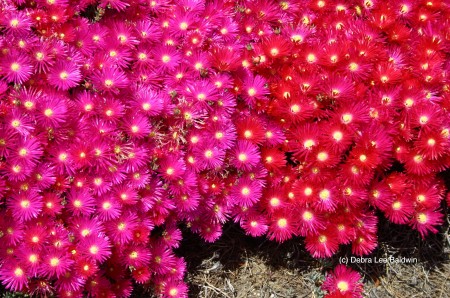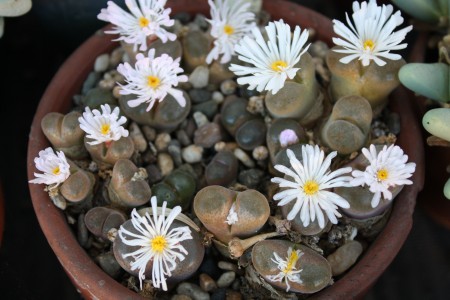
Is it any wonder I’m such a fan of succulents? In addition to being easy care, low-water and having architectural shapes, they send forth spectacular flowers. Some of the most amazing are those of aloes, most of which bloom in midwinter (in temperate climates). Shown above is Aloe x ‘David Verity’, in Patrick Anderson’s Fallbrook, CA garden.

These Aloe striata grow en masse at Rancho La Puerta fitness spa in Baja California.

And this incredible Aloe marlothii is at Desert Theater nursery in Escondido, CA. In bloom the plant is 5 feet tall!

Aloe flowers come in shades of red, cream, coral and yellow. Ice plants produce neon-bright, satiny, daisylike flowers in all of those hues, plus lavender, magenta and purple.

Although ice plants are generally thought of as ground covers, they also serve well as fillers and cascaders for pots. In this composition, the designers at Chicweed (Solana Beach, CA) combined lavender ice plant with deep purple tradescantia.

Lithops and other living stones are ice plants, too. You can tell by the flowers.

Here’s another one — Pleiospilos. Pleis don’t ask me how to pronounce it.

Kalanchoes also produce flowers that make you stop and stare. Some, like this bryophyllum (a type of kalanchoe that produces plantlets on its leaves), have airy clusters of tubular flowers.

Others, like this assortment of supermarket kalanchoes (K. blossfeldiana) are small and star-shaped. Because it blooms profusely and repeatedly with masses of long-lasting flowers, the species has been hybridized extensively.

There even are multipetalled varieties (“calandivas”).

Agaves aren’t known for their flowers—in fact, you don’t want an agave to bloom, because they’re monocarpic (die after flowering), but fortunately it can take years for that to happen. When it does, it’s an event—as you can see by these Agave vilmoriniana (octopus agaves) that decided to go off together (they probably were litter mates). For more on this topic, check out my earlier post, “Uh-Oh, My Agave’s Blooming.”

Aeoniums also are monocarpic. The rosette elongates into a conical flower spike. But not all rosettes in a cluster bloom at once, so it’s not a great loss. I pick aeonium flower spikes like those shown here and plunk them into a 3-foot-tall terracotta vase in my home’s entryway. They look good for several weeks…without water. (Hey, they’re succulents. Even the petals are waxy and store moisture.)

A favorite succulent for containers, echeveria, resembles a flower AND produces wonderful blooms.

Calandrinia flowers resemble satiny purple poppies and are held aloft on slender stems. I think they look best when grown in mass.

But when it comes to vivid colors and exquisite blooms, the type of succulent that does it best is (drum roll): Cactus!

Yep, those spiny plants that you swear you’ll never have in your garden—and I don’t blame you—produce satiny, translucent flowers so lovely they’ll make you gasp.

But you have to catch them on the right day. Cactus flowers don’t last long—maybe two days at most. But they’re worth planning your vacation around.
An update: Since posting this, I’ve added a fourth photo CD to my line: Succulent Flowers. 370 photos of succulents in bloom, each labeled according to genus and species. Like my other three CDs, it’s available through my website. — Debra
My goal is to share the beauty of waterwise, easy-care succulents in gardens, containers and landscapes via blog posts, newsletters, public speaking and workshops, photos, videos, merchandise, and social media (Facebook and Pinterest). My books: Designing with Succulents, Succulent Container Gardens, and Succulents Simplified. www.debraleebaldwin.com
